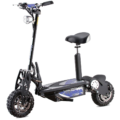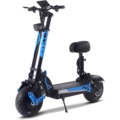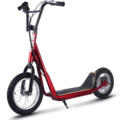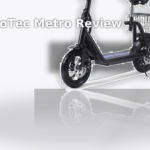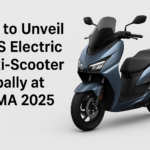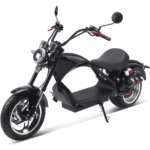- Home
- Scooters
- Electric Scooters
- MotoTec Diablo
MotoTec Diablo
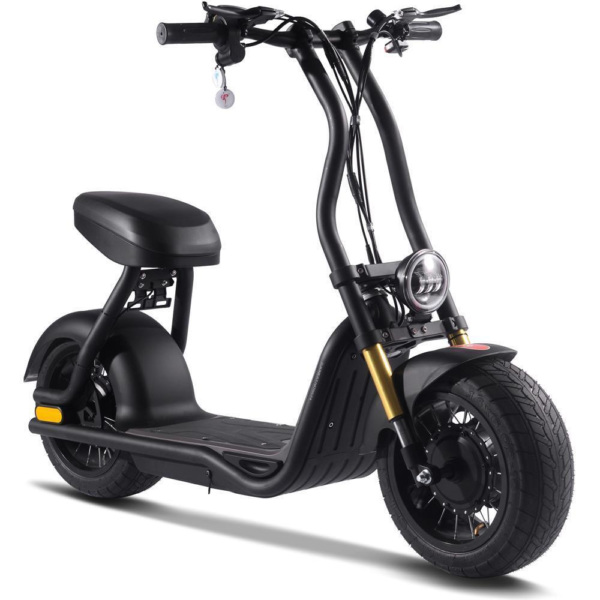



- Battery Range: 10–20 miles (16–32 km)
- Top Speed: 25 mph (40 km/h)
- Motor Power: 1000 W
- Weight Capacity: 265 lb (120.2 kg)
- Charging Time: ~6–8 h
- Scooter Weight: 84.0 lb (38.1 kg)
PROS
- Fat 10″ tires for stability
- Front dual shocks
- Rear hub motor torque
- Front & rear disc brakes
- Key start + battery meter
CONS
- Heavy at 84 lb
- Shorter range (10–20 mi)
- No app or regen listed
- Folding mechanism not specified
Key Takeaways
- The MotoTec Diablo is a seated electric scooter designed for stability and comfort, ideal for new riders and short commutes.
- It features a 1000W rear-hub motor and a 48V 13Ah battery, providing good range and a top speed of 25 mph.
- The scooter uses a simple control layout with a twist throttle and mechanical disc brakes for easy handling.
- Its durable design includes wide tires, a sturdy frame, and a low center of gravity for better comfort and control.
- While perfect for neighborhood rides, it’s not suited for heavy rain or daily transport up stairs.
Table of contents
- What Is the MotoTec Diablo?
- How the MotoTec Diablo Works
- Key Specifications
- Design & Build Quality
- Performance Fundamentals
- Battery, Range & Efficiency
- Ride Quality & Comfort
- Braking & Safety Features
- Portability & Daily Usability
- Maintenance & Care
- Weather & Seasonal Considerations
- MotoTec Diablo vs Alternatives
- Who the MotoTec Diablo Is (and Isn’t) For
- FAQs
- Glossary
The MotoTec Diablo is a seated, fat-tire electric scooter made for easy rides and short hops. It favors comfort over flash, and it feels steady at neighborhood pace. So it suits new riders, casual commuters, and anyone who wants a simple sit-down scooter. Plus, it carries a bigger rider without drama.
What Is the MotoTec Diablo?
The MotoTec Diablo runs a 48-volt, 1000-watt rear-hub motor under a steel frame with wide 14-inch tires. It has a padded seat, a twist throttle, and dual front shocks. So the controls feel familiar, and the ride stays calm on rough blocks. The layout is basic. You turn a key, check a battery meter, and roll out.
Riders who want low stress will like it. The stance sits planted, and the seat height keeps both feet flat when you stop. And the wide bar gives good leverage in slow turns or tight parking. In daily use, you start it, glance at charge, and go. There’s no app to learn and no menus to poke.
How the MotoTec Diablo Works
Think in five pieces that team up: motor, controller, battery, throttle, and brakes. Each one is simple, and the whole scooter feels predictable.
Motor. A brushless hub hides in the rear wheel. It pulls from the 48V pack and gives steady torque from zero. So launches feel smooth, and mid-range pull builds in a clean arc. The hub design keeps the drivetrain clean and quiet.
Controller. A small controller meters current to the motor. It trims spikes and protects the pack from harsh draws. As a result, heat stays in check on warm days, and range stays steady from ride to ride.
Battery. The 48V 13Ah pack stores about 624 Wh. That size fits short commutes and relaxed weekend loops. And it plugs into a regular wall outlet with the stock charger.
Throttle. A twist grip sets speed. You roll on to accelerate, and you ease off to slow. So your right hand does most of the work. An economy button caps power when you want to stretch range on flat routes.
Brakes. Front and rear mechanical discs handle stopping. Lever pull ramps pad bite in a smooth band, and the fat tires add grip. In dry weather, stops feel direct and easy to control.
Key Specifications
| Block | Item | Value |
|---|---|---|
| General | Model | MotoTec Diablo |
| Frame | High-tensile steel | |
| Foot deck | ABS resin | |
| Rider capacity | 265 lb (120 kg) | |
| Recommended age | 13+ | |
| Performance & Power | Motor | Rear hub, 48V 1000W |
| Top speed | 25 mph (≈40 km/h), two selectable speeds | |
| Throttle | Twist | |
| Economy mode | Yes | |
| Battery, Charging & Electrical | Battery | 48V 13Ah lithium-ion (≈624 Wh) |
| Range (rated) | 10–20 mi (≈16–32 km), route and rider dependent | |
| Charge time | 6–8 hours | |
| Battery meter | Yes | |
| Lights | LED headlight and tail/brake light | |
| Build & Dimensions | Tires | 14×6.00-10 fat tires |
| Suspension | Dual front shocks | |
| Ground clearance | 4 in (≈102 mm) | |
| Wheelbase | 36.4 in (≈925 mm) | |
| Seat height | 30 in (≈762 mm) | |
| Size (assembled) | 55×25×38 in (≈140×64×97 cm) | |
| Folded dimensions | Not specified by the manufacturer | |
| Scooter weight | 84 lb (≈38 kg) | |
| Safety & Control | Brakes | Front and rear disc |
| Fenders | Front and rear | |
| Features & Extras | Key start | Yes |
| Cruise control | Not specified | |
| Warranty & Compliance | Warranty | 60-day parts replacement |
| Compliance notes | Local road rules vary by region |
These specifications paint a clear picture of size, power, and range. And they help you plan storage, transport, and daily routes before you commit.
Design & Build Quality
The Diablo looks like a compact scooter-moped hybrid. The steel frame sets a sturdy base, and the fat tires give it a planted stance. Then the ABS panels take small scuffs without ugly dents. Fit and finish land on the practical side, which works for a bike path cruiser. Cable runs stay tidy, and paint holds up with normal care.
Up front, dual shocks carry visible travel. So the bar stays calm across cracked asphalt and curb cuts. The fenders catch spray and grit on wet days, which keeps the cockpit cleaner. Meanwhile, the seat uses medium-firm foam that feels fine for short to medium rides. The deck lets you rest your feet at a natural angle. And the wide bar gives leverage in slow maneuvers.
The cockpit keeps it simple. You get two brake levers, a twist throttle, an economy button, and a battery meter. That’s it, and it’s enough. As a result, you spend less time fiddling and more time riding. One small touch that stands out: the center of mass sits low. So the scooter feels steady at walking speed and when you push it around a garage.
Performance Fundamentals
The 1000W hub favors steady pull over snap. So it steps off cleanly, then builds speed in a smooth curve. On flat ground it cruises near neighborhood limits without fuss. And the two-speed selector helps you start slow, then unlock more pace when you feel ready.
Hills change the picture a bit. On 7–10% grades, speed drops, yet the scooter keeps moving. Then technique helps. Carry a bit of momentum into the slope, hold a steady wrist, and keep your line smooth. Long climbs ask more from the pack, so plan a small buffer if your ride includes extended hills. Headwinds act like a mild grade and can trim a few mph.
Stability is a strong suit. The long wheelbase and wide contact patch calm the chassis. So the front tracks straight, and small seams don’t knock it offline. At the bar, light inputs set a steady arc, which feels nice on winding paths. The same weight that makes lifting tough helps the ride feel planted at speed.
Battery, Range & Efficiency
The 48V 13Ah pack holds about 624 Wh. In mixed use with a 180 lb rider, many folks see mid-teens miles. Lighter riders on flat paths at a steady pace can land near the top of the rated window. Cold temps and hills cut range, and stop-and-go adds extra draw. So plan your loop with room to spare.
Charging from low sits around 6–8 hours on the stock charger. That timing fits an overnight routine and pairs well with daily short trips. For best pack health, plug in after rides, and avoid long storage near empty. Then, if you’ll park the scooter for a few weeks, leave the pack around half charge and check it monthly.
Fat tires ride soft, yet they add rolling drag. So pressure matters. Set it within the maker’s range for your weight, and recheck often. In practice, correct pressure gives better range, calmer steering, and cooler running. Under-inflated tires feel heavy at the bar and waste energy as heat. Over-inflated tires feel harsh and can skip over rough patches.
Ride Quality & Comfort
Comfort is the Diablo’s theme. The wide tires act like soft springs at low speed. Then the tall sidewalls round off sharp edges from cracks and patch seams. Up front, the dual shocks add another filter, so your hands feel less chatter on rough blocks. The 30-inch seat height keeps knees relaxed, and the upright posture reduces wrist load.
Grooved pavement can tug at the front, since fat tires like to follow lines. Even so, a light grip and a steady gaze calm that effect. Pressure checks help again. Too low makes steering sluggish, and too high adds harshness. A small hand pump and a low-range gauge pay for themselves fast.
The front assembly is fixed, so stem flex stays low. The scooter tracks straight during quick lane changes and firm braking. On longer rides, stop now and then to stretch and reset your hips. Short breaks do more for comfort than you’d expect.
Braking & Safety Features
The Diablo uses front and rear mechanical discs. Lever pull gives a smooth rise in bite after the halfway point. So stops feel predictable, and low-speed control stays easy near the line. Dry pavement shortens braking distance thanks to the wide contact patch. In the wet, lighten inputs and shift your weight back. Then you’ll keep the front planted and the rear in line.
Lighting is simple and useful. The LED headlight marks your presence and lights a short path. The tail lamp brightens when you brake. Side reflectors add pop from car lights. An IP rating isn’t listed, so treat water with care. After wet rides, wipe the scooter down, clear grit from the brakes, and let the pack dry before you charge.
Portability & Daily Usability
This scooter isn’t a stair climber. At about 84 lb, it’s tough to carry up long flights. So plan ground-level storage when you can, and use ramps for vans or garages. The frame isn’t a quick-fold commuter design either. You roll it short distances and load it upright for transport.
Daily habits stay easy, though. You turn the key, check charge, and go. The economy button helps on long flat routes. Parking is simple with the included stand. For security, lock through the frame with a stout chain. Then add a basic cover to hide the shape if you store outside.
Maintenance & Care
A simple schedule keeps the Diablo riding well.
- Before each ride: Check tire pressure. Squeeze both brakes. Verify lights. Scan for loose fasteners.
- Weekly: Wipe the hub area and rotors. Check axle nuts. Inspect cable ends and lever pivots.
- Monthly: Check pad wear and rotor true. Re-torque stem and bar bolts to the manual spec. Look over wiring sheaths near the head tube.
- Every 3–6 months: Clean and dielectric-grease exposed connectors. Run one full charge cycle to balance the pack. Inspect tires for cuts and embedded debris.
Use a damp cloth on plastics and a mild bike cleaner on metal. Keep solvents off rotors and pads. Then store the scooter in a cool, dry spot. If you won’t ride for a while, leave the battery around half charge and top it up monthly.
Weather & Seasonal Considerations
Rain trims grip and range. So slow down, brake early, and keep the scooter upright across paint and metal plates. Puddles hide holes that can pinch a rim or knock you offline. After wet rides, dry the scooter and clear grit from the brakes. Cold weather lowers battery output and stiffens rubber. Then range drops, and tires need a few minutes to warm. Hot days raise pack stress. So park in the shade, and let the pack cool before you charge after a hard ride.
Night rides need extra care. Use the built-in lights, add reflective gear, and pick routes with clean sight lines. In summer, check pressure more often, since heat bumps readings. In winter, top off before you roll, since pressure falls with the temp.
MotoTec Diablo vs Alternatives
The Diablo shines when comfort and simplicity matter more than speed. It beats slim commuters on seated comfort, bar leverage, and weight capacity. It beats larger hot-rod scooters on price and ease of use. So it sits between fast stand-up models and heavy dual-sport rigs.
If you want a slimmer seated scooter with a lighter frame, the MotoTec Metro fits tight storage and short city hops. For a deeper look at how it rides, see the MotoTec Metro review.
If you carry a scooter on trains, a light 36–48V folder fits better. If you want sharp snap and higher top speed, a twin-motor performance model wins. If you want real trail chops, you’ll want knobbier tires and more suspension travel. Even so, the Diablo handles light gravel and packed dirt in dry weather. The fat tires float over small ruts, and the front shocks take the sting out of washboard.
Who the MotoTec Diablo Is (and Isn’t) For
Great for:
- Riders who want a seat, a stable chassis, and a calm ride.
- Bigger riders who need higher weight capacity in a compact footprint.
- Short city loops, campus trips, RV park rides, and neighborhood errands.
- New riders who want simple controls and a short learning curve.
Not ideal for:
- Daily train commuters who must carry a scooter upstairs.
- Riders who want sharp acceleration or very high speed.
- People who ride in heavy rain or need a listed IP rating.
- Apartment dwellers with no ground-level storage.
FAQs
1) What is the real-world top speed?
On flat ground in full-power mode, many riders see speeds near the rated 25 mph. Wind and rider weight change the result a bit.
2) How far can I ride on one charge?
Plan for mid-teens miles on mixed routes with an average rider. Flat paths at steady pace stretch range, and hills or cold shorten it.
3) Does the Diablo have cruise control?
An economy button caps power to stretch range on easy routes. Cruise control isn’t listed, so ride with a steady wrist on long straights.
4) What tire pressure should I run?
Follow the sidewall and the manual. Set pressure for your weight and the day’s temps, then recheck monthly for best feel.
5) How steep a hill can it climb?
Short 7–10% grades are fine at reduced speed. Long climbs slow more. Carry momentum and keep inputs smooth.
6) Is the MotoTec Diablo street-legal everywhere?
Rules vary by city and state. So check local limits on road use, bike lanes, and helmets before you ride.
7) Where can I read a concise MotoTec Diablo overview?
You’re reading it now. This guide gathers the highlights, specs, care tips, and use cases in one place.
Glossary
- Ah (amp-hours): Battery size. Multiply by volts to estimate watt-hours.
- Wh (watt-hours): Stored energy. Higher Wh usually means longer range.
- Controller: Electronics that meter current to the motor.
- Hub motor: A motor inside the wheel hub. Quiet and low-maintenance.
- Regen: Electronic braking that feeds a small bit of energy back. Not listed here.
- Stem flex: How much the steering column bends under load.
- IP rating: Dust and water rating. Not listed for this model.
- Torque: Turning force that helps with starts and hills.
- Wheelbase: Distance between axles. A longer base adds stability.
- Ground clearance: Space under the chassis for ramps and curbs.
- Disc brake: Rotor and caliper system for direct braking.
- Economy mode: Power cap that can extend range on flat routes.
- Fat tire: A wide tire with tall sidewalls for comfort and grip.
- Lithium-ion: Battery chemistry with strong energy density.
- Rim size: The diameter of the wheel the tire mounts to.
Specifications
General
| Model The Model specifies the exact version or name of the scooter. It helps identify its unique design, features, and specifications within the manufacturer’s product line. Knowing the model makes it easier to compare options, find compatible accessories, or look up support information. | Diablo |
| Brand The Brand identifies the manufacturer or company that designs and produces the scooter. A trusted brand is a sign of quality, reliability, and good customer support. Well-known brands often have higher standards for safety, performance, and after-sales service, giving you more confidence in your purchase. | MotoTec |
| Release Date The Release Date indicates when the scooter model was officially launched on the market. This helps you know how current the design, technology, and features are. A newer release date often means updated components, improved performance, and the latest safety or smart features. | 18 November 2025 |
| Recommended Age Recommended Age indicates the minimum age range that the scooter is designed for, based on safety, size, and ease of use. Following the recommended age helps ensure that riders can handle the scooter’s speed, weight, and controls comfortably and safely. Always check local laws and use protective gear, especially for younger riders. | 13+ |
Performance & Power
| Motor Power (Wattage) What it means: The motor power, measured in watts (W), shows how strong the scooter’s electric motor is. Why it matters: Higher wattage usually means better acceleration, more torque, and improved performance on hills or rough terrain. For example, a 250W motor is good for flat city roads and light riders, while a 500W or 1000W motor provides more power for faster speeds or climbing steep inclines. | 48 V 1000 W rear hub (brushless) |
| Top Speed The Top Speed indicates the maximum speed that the scooter can reach under optimal conditions. It’s usually measured on level ground with a fully charged battery and an average rider weight. A higher top speed allows you to travel longer distances faster, but always ensure you ride within legal speed limits and your personal comfort zone for safety. | 25 mph (40 km/h); 2 speed selectable (15/25 mph) |
| Battery Capacity Battery Capacity refers to the total amount of energy the scooter’s battery can store, usually measured in ampere-hours (Ah) or watt-hours (Wh). A higher battery capacity means you can ride longer distances on a single charge, reducing the need for frequent recharging. Keep in mind that actual range can vary depending on rider weight, terrain, speed, and weather conditions. | 48 V 13 Ah (624 Wh) |
| Estimated Range per Charge The Estimated Range per Charge indicates the average distance the scooter can travel on a single full battery charge. This range is calculated under optimal conditions, such as flat terrain, moderate speed, and average rider weight. Real-world range may vary depending on riding style, terrain, weather, and load. A longer range means fewer recharges and greater freedom for longer trips. | 10–20 miles (16–32 km) |
| Hill Climb Ability Hill Climb Ability describes the maximum incline or slope that the scooter can handle while maintaining stable performance. It’s typically expressed as a percentage or in degrees. A higher hill climb rating means the scooter can tackle steeper hills without losing too much speed or power. Actual climbing performance may vary based on rider weight, battery charge, and terrain conditions. | Not specified |
| Drive System The Drive System refers to how power from the motor is delivered to the wheels. Electric scooters typically use either a hub motor (directly integrated into the wheel) or a chain/belt drive system. A high-quality drive system ensures smooth acceleration, efficient power transfer, and low maintenance. The choice of drive system affects performance, noise level, and overall ride experience. | Rear hub (RWD) |
Charging & Electrical
| Charging Time Charging Time indicates how long it takes to fully recharge the scooter’s battery from empty to 100% using the standard charger provided. Faster charging means less downtime and more time on the road. Actual charging time may vary slightly depending on battery capacity, charger output, and environmental conditions. | Approx. 6–8 hours |
| Battery Type Battery Type refers to the specific technology used in the scooter’s battery, which affects performance, lifespan, weight, and charging time. Most modern electric scooters use high-quality lithium-ion (Li-ion) batteries because they offer a good balance of energy density, durability, and low maintenance. A reliable battery type ensures consistent power delivery and longer riding ranges. | Lithium-ion pack |
| Removable Battery A Removable Battery means the battery pack can be easily detached from the scooter for convenient charging and replacement. This feature allows you to charge the battery separately, swap it with a spare for extended range, or securely store it indoors in extreme weather. Removable batteries add flexibility and make it easier to keep your scooter powered up wherever you are. | Non-removable internal battery (fixed pack) |
| Regenerative Braking Regenerative Braking is an energy-saving feature that converts some of the energy normally lost during braking back into battery power. When you slow down or brake, the motor works in reverse to generate electricity, which helps extend the scooter’s range and improves overall efficiency. This system also reduces wear on traditional brake components, leading to lower maintenance over time. | No |
| Lighting Lighting refers to the built-in front and rear lights that enhance visibility and safety when riding in low-light conditions or at night. Good lighting helps you see the road ahead and ensures that other road users can see you. Many scooters include LED headlights, taillights, and sometimes brake lights or side reflectors for added safety and compliance with local traffic regulations. | LED headlight + rear LED/brake |
Build & Dimensions
| Scooter Weight Scooter Weight refers to the total weight of the scooter when fully assembled, including the battery. This affects how easy it is to carry, lift, and store the scooter when not in use. A lighter scooter is more portable and convenient for commuting, especially if you need to carry it upstairs or onto public transport. Keep in mind that a sturdy frame and quality components may add to the weight but also contribute to better durability and ride stability. | 84.0 lb (38.1 kg) |
| Maximum Rider Weight Maximum Rider Weight indicates the highest rider weight that the scooter is designed to safely support while maintaining optimal performance and stability. Staying within this limit helps ensure reliable acceleration, braking, and climbing ability, and it protects the frame, suspension, and motor from excessive strain. Exceeding the recommended limit may reduce performance and increase wear on components. | 265 lb (120.2 kg) |
| Deck Size Deck Size refers to the dimensions of the scooter’s standing platform. A wider and longer deck provides more foot space, allowing you to stand comfortably and adjust your stance while riding. A well-sized deck improves balance and stability, especially on longer rides or at higher speeds. Compact decks, on the other hand, help keep the scooter lightweight and portable. | High-tensile steel frame; fat-tire geometry; seat |
| Handlebar Height Handlebar Height refers to the distance from the deck to the handlebars, which affects your riding posture and comfort. An appropriate handlebar height helps you maintain good balance, reduces strain on your back and arms, and makes steering more comfortable. Some scooters have adjustable handlebars to fit riders of different heights, while others have a fixed height for a streamlined design. | Not specified |
| Folding Mechanism The Folding Mechanism describes how easily and securely the scooter can be folded for carrying and storage. A well-designed folding system lets you quickly collapse the scooter into a compact size, making it convenient to transport on public transit, store under a desk, or fit into a car trunk. Look for sturdy latches and safety locks to ensure the scooter stays firmly in place when folded or unfolded. | Not specified |
| Dimensions Folded Dimensions indicate the size of the scooter when it’s fully folded. This measurement shows how much space the scooter will take up when stored or carried, making it easier to check if it will fit in your car trunk, under a desk, or in a closet. Compact folded dimensions are ideal for commuters who need to bring their scooter on public transport or store it in tight spaces. | Unfolded: 55 × 25 × 38 in; Folded: Not specified |
| Material Material refers to the primary construction materials used for the scooter’s frame and key components. High-quality materials like aircraft-grade aluminum, reinforced steel, or durable composites provide strength, stability, and a lighter overall weight. A sturdy material ensures the scooter can handle daily wear and tear while maintaining safety and performance. | Steel frame; ABS deck |
Safety & Control
| Brake Type(s) Brake Type(s) describe the braking systems the scooter uses to help you slow down or stop safely. Common brake types include mechanical brakes (like drum or disc brakes), electronic brakes, and foot brakes. Many scooters combine multiple braking systems for added safety and shorter stopping distances. The type and quality of brakes affect your control, especially when riding at higher speeds or on slopes. | Front & rear disc |
| Suspension Suspension refers to the system that absorbs shocks and vibrations while riding, providing a smoother and more comfortable ride over uneven or rough surfaces. Scooters may have front suspension, rear suspension, or dual suspension for better shock absorption and stability. Good suspension helps reduce rider fatigue and improves control, especially when riding on bumpy roads or off-road paths. | Dual front suspension |
| Tire Type Tire Type refers to the kind of tires the scooter uses, which directly affects ride comfort, traction, and maintenance. Common types include solid (airless) tires, pneumatic (air-filled) tires, or hybrid options. Pneumatic tires offer better shock absorption and a smoother ride on rough surfaces, while solid tires are puncture-proof and require less upkeep. The right tire type helps ensure safe handling and a comfortable ride in different conditions. | 10″ pneumatic fat tires (14×6.00-10) |
| Tire Size Tire Size indicates the diameter and width of the scooter’s tires, which affect ride comfort, stability, and how well the scooter handles different terrains. Larger tires generally offer better shock absorption and a smoother ride over bumps and rough surfaces, while smaller tires keep the scooter lighter and more portable. Choosing the right tire size helps ensure a balance between agility and comfort. | 10-inch |
| Kickstand The Kickstand is a built-in stand that allows you to park your scooter upright when it’s not in use. A sturdy kickstand keeps the scooter stable and prevents it from tipping over, protecting it from scratches and damage. It also makes storing and accessing your scooter more convenient, whether you’re at home, work, or on the go. | Not specified |
| Water Resistance Rating Water Resistance Rating indicates how well the scooter is protected against water and moisture, usually shown as an IP (Ingress Protection) rating. This rating helps you understand whether the scooter can handle light rain, splashes, or wet roads without damage. While most scooters are not fully waterproof, a good water resistance rating adds peace of mind when riding in changing weather conditions. Always avoid deep puddles or submerging the scooter to protect its electrical components. | Not specified |
Features & Extras
| Display/Console The Display (or Console) shows important real-time information about your ride, helping you monitor your scooter’s status at a glance. Typical displays show speed, battery level, distance traveled, and riding mode. Some models also include additional features like Bluetooth connectivity, app integration, or backlighting for better visibility at night. A clear and easy-to-read display enhances safety and convenience on every trip. | Battery meter (twist throttle housing) |
| Ride Modes Ride Modes refer to the different speed and power settings you can choose to match your riding style or road conditions. Common modes include eco for maximum range and energy efficiency, standard for everyday balance, and sport or turbo for higher speed and stronger acceleration. Switching between ride modes allows you to customize performance, conserve battery, and ride safely in various environments. | 2 modes (economy/normal) |
| Smart App Connectivity Smart App Connectivity lets you pair your scooter with a dedicated mobile app via Bluetooth. Using the app, you can monitor real-time ride stats like speed, battery level, and range, adjust settings such as ride modes or cruise control, lock the scooter for added security, and sometimes receive firmware updates. This feature adds convenience and allows you to personalize your riding experience right from your smartphone. | No companion app |
| Anti-Theft System The Anti-Theft System helps protect your scooter from unauthorized use or theft. This feature can include built-in alarms, electronic motor locks, GPS tracking, or remote locking through a mobile app. A good anti-theft system provides peace of mind when parking your scooter in public spaces, adding an extra layer of security to safeguard your investment. | Key start |
| Cruise Control Cruise Control allows you to maintain a steady speed without continuously holding the throttle. This feature makes longer rides more comfortable by reducing hand fatigue and providing a smoother, more relaxed riding experience — especially on flat, open roads or bike lanes. For safety, cruise control can usually be easily activated or deactivated while riding. | No |
| Accessories Included Accessories Included lists the additional items that come with the scooter to enhance your riding experience and convenience. Common accessories may include a charger, kickstand, bell, lights, phone holder, or carrying strap. These extras add value by making your scooter safer, easier to use, and ready to ride straight out of the box. | Scooter, charger, seat, tools, manual |
Warranty & Compliance
| Warranty Period The Warranty Period indicates how long the manufacturer guarantees the scooter against defects in materials and workmanship under normal use. A good warranty provides peace of mind, showing the brand’s confidence in its product quality. Always check what parts are covered, such as the frame, battery, and motor, and follow the maintenance guidelines to keep your warranty valid. | 60 days parts replacement |
| Certifications Certifications confirm that the scooter meets specific safety, quality, and environmental standards set by recognized organizations or regulatory bodies. Common certifications may include CE, RoHS, UL, or other local compliance marks, depending on your region. These certifications ensure that the scooter is manufactured to high standards and is safe and legal to use in your country. | Region-dependent |


